Table of Contents
Chapter 11
Algebra
11.1 Introduction
Our study so far has been with numbers and shapes. We have learnt numbers, operations on numbers and properties of numbers. We applied our knowledge of numbers to various problems in our life. The branch of mathematics in which we studied numbers is arithmetic. We have also learnt about figures in two and three dimensions and their properties. The branch of mathematics in which we studied shapes is geometry. Now we begin the study of another branch of mathematics. It is called algebra.
The main feature of the new branch which we are going to study is the use of letters. Use of letters will allow us to write rules and formulas in a general way. By using letters, we can talk about any number and not just a particular number. Secondly, letters may stand for unknown quantities. By learning methods of determining unknowns, we develop powerful tools for solving puzzles and many problems from daily life. Thirdly, since letters stand for numbers, operations can be performed on them as on numbers. This leads to the study of algebraic expressions and their properties.
You will find algebra interesting and useful. It is very useful in solving problems. Let us begin our study with simple examples.
11.2 Matchstick Patterns
Ameena and Sarita are making patterns with matchsticks. They decide to make simple patterns of the letters of the English alphabet. Ameena takes two matchsticks and forms the letter L as shown in Fig 11.1 (a).

Then Sarita also picks two sticks, forms another letter L and puts it next to the one made by Ameena [Fig 11.1 (b)].
Then Ameena adds one more L and this goes on as shown by the dots in Fig 11.1 (c).
Their friend Appu comes in. He looks at the pattern. Appu always asks questions. He asks the girls, “How many matchsticks will be required to make seven Ls”? Ameena and Sarita are systematic. They go on forming the patterns with 1L, 2Ls, 3Ls, and so on and prepare a table.

Appu gets the answer to his question from the Table 1; 7Ls require 14 matchsticks.
While writing the table, Ameena realises that the number of matchsticks required is twice the number of Ls formed.

Number of matchsticks required = 2 × number of Ls.
For convenience, let us write the letter n for the number of Ls. If one L is made, n = 1; if two Ls are made, n = 2 and so on; thus, n can be any natural number 1, 2, 3, 4, 5, .... We then write, Number of matchsticks required = 2 × n.

Instead of writing 2 × n, we write 2n. Note that 2n is same as 2 × n.
Ameena tells her friends that her rule gives the number of matchsticks required for forming any number of Ls.
Thus, For n = 1, the number of matchsticks required = 2 × 1 = 2
For n = 2, the number of matchsticks required = 2 × 2 = 4
For n = 3, the number of matchsticks required = 2 × 3 = 6 etc.
These numbers agree with those from Table 1.
Sarita says, “The rule is very powerful! Using the rule, I can say how many matchsticks are required to form even 100 Ls. I do not need to draw the pattern or make a table, once the rule is known”.
Do you agree with Sarita?
11.3 The Idea of a Variable
In the above example, we found a rule to give the number of matchsticks required to make a pattern of Ls. The rule was :
Number of matchsticks required = 2n
Here, n is the number of Ls in the pattern, and n takes values 1, 2, 3, 4,.... Let us look at Table 1 once again. In the table, the value of n goes on changing (increasing). As a result, the number of matchsticks required also goes on changing (increasing).
n is an example of a variable. Its value is not fixed; it can take any value 1, 2, 3, 4, ... . We wrote the rule for the number of matchsticks required using the variable n.
The word ‘variable’ means something that can vary, i.e. change. The value of a variable is not fixed. It can take different values.
We shall look at another example of matchstick patterns to learn more about variables.
11.4 More Matchstick Patterns
Ameena and Sarita have become quite interested in matchstick patterns. They now want to try a pattern of the letter C. To make one C, they use three matchsticks as shown in Fig. 11.2(a).

Table 2 gives the number of matchsticks required to make a pattern of Cs.

Can you complete the entries left blank in the table?
Sarita comes up with the rule :
Number of matchsticks required = 3n
She has used the letter n for the number of Cs; n is a variable taking on values 1, 2, 3, 4, ...
Do you agree with Sarita ?
Remember 3n is the same as 3 × n.
Next, Ameena and Sarita wish to make a pattern of Fs. They make one F using 4 matchsticks as shown in Fig 11.3(a).

Can you now write the rule for making patterns of F?
Think of other letters of the alphabet and other shapes that can be made from matchsticks. For example, U ( ), V (
), V ( ), triangle (
), triangle ( ), square (
), square ( ) etc. Choose any five and write the rules for making matchstick patterns with them.
) etc. Choose any five and write the rules for making matchstick patterns with them.
11.5 More Examples of Variables
We have used the letter n to show a variable. Raju asks, “Why not m”?
There is nothing special about n, any letter can be used.
One may use any letter as m, l, p, x, y, z etc. to show a variable.Remember, a variable is a number which does not have a fixed value. For example, the number 5 or the number 100 or any other given number is not a variable. They have fixed values. Similarly, the number of angles of a triangle has a fixed value i.e. 3. It is not a variable. The number of corners of a quadrilateral (4) is fixed; it is also not a variable. But n in the examples we have looked is a variable. It takes on various values 1, 2, 3, 4, ... .
Let us now consider variables in a more familiar situation.
Students went to buy notebooks from the school bookstore. Price of one notebook is
` 5. Munnu wants to buy 5 notebooks, Appu wants to buy 7 notebooks, Sara wants to buy 4 notebooks and so on. How much money should a student carry when she or he goes to the bookstore to buy notebooks?

This will depend on how many notebooks the student wants to buy. The students work together to prepare a table.

The letter m stands for the number of notebooks a student wants to buy; m is a variable, which can take any value 1, 2, 3, 4, ... . The total cost of m notebooks is given by the rule :
The total cost in rupees = 5 × number of note books required
= 5m
If Munnu wants to buy 5 notebooks, then taking m = 5, we say that Munnu should carry
₹ 5 × 5 or ₹ 25 with him to the school bookstore.
Let us take one more example. For the Republic Day celebration in the school, children are going to perform mass drill in the presence of the chief guest. They stand 10 in a row (Fig 11.4). How many children can there be in the drill?
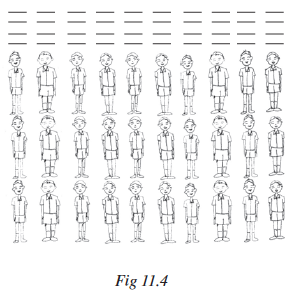
The number of children will depend on the number of rows. If there is 1 row, there will be 10 children. If there are 2 rows, there will be 2 × 10 or 20 children and so on. If there are r rows, there will be 10r children in the drill; here, r is a variable which stands for the number of rows and so takes on values 1, 2, 3, 4, ... .
In all the examples seen so far, the variable was multiplied by a number. There can be different situations as well in which numbers are added to or subtracted from the variable as seen below.
Sarita says that she has 10 more marbles in her collection than Ameena. If Ameena has 20 marbles, then Sarita has 30. If Ameena has 30 marbles, then Sarita has 40 and so on. We do not know exactly how many marbles Ameena has. She may have any number of marbles.
But we know that, Sarita’s marbles = Ameena’s marbles + 10.
We shall denote Ameena’s marbles by the letter x. Here, x is a variable, which can take any value 1, 2, 3, 4,... ,10,... ,20,... ,30,... . Using x, we write Sarita’s marbles = x + 10. The expression (x + 10) is read as ‘x plus ten’. It means 10 added to x. If x is 20, (x + 10) is 30. If x is 30, (x + 10) is 40 and so on.
The expression (x + 10) cannot be simplified further.
Do not confuse x + 10 with 10x, they are different.
In 10x, x is multiplied by 10. In (x + 10), 10 is added to x.
We may check this for some values of x.
For example,
If x = 2, 10x = 10 × 2 = 20 and x + 10 = 2 + 10 = 12.
If x = 10, 10x = 10 × 10 = 100 and x + 10 = 10 + 10 = 20.

Raju and Balu are brothers. Balu is younger than Raju by 3 years. When Raju is 12 years old, Balu is 9 years old. When Raju is 15 years old, Balu is 12 years old. We do not know Raju’s age exactly. It may have any value. Let x denote Raju’s age in years, x is a variable. If Raju’s age in years is x, then Balu’s age in years is (x – 3). The expression (x – 3) is read as x minus three. As you would expect, when x is 12,
(x – 3) is 9 and when x is 15, (x – 3) is 12.
Exercise 11.1
1. Find the rule which gives the number of matchsticks required to make the following matchstick patterns. Use a variable to write the rule.
(a) A pattern of letter T as 
(b) A pattern of letter Z as 
(c) A pattern of letter U as 
(d) A pattern of letter V as 
(e) A pattern of letter E as 
(f) A pattern of letter S as 
(g) A pattern of letter A as 
2. We already know the rule for the pattern of letters L, C and F. Some of the letters from Q.1 (given above) give us the same rule as that given by L. Which are these? Why does this happen?
3. Cadets are marching in a parade. There are 5 cadets in a row. What is the rule which gives the number of cadets, given the number of rows? (Use n for the number of rows.)
4. If there are 50 mangoes in a box, how will you write the total number of mangoes in terms of the number of boxes? (Use b for the number of boxes.)
5. The teacher distributes 5 pencils per student. Can you tell how many pencils are needed, given the number of students? (Use s for the number of students.)
6. A bird flies 1 kilometer in one minute. Can you express the distance covered by the bird in terms of its flying time in minutes? (Use t for flying time in minutes.)
7. Radha is drawing a dot Rangoli (a beautiful pattern of lines joining dots) with chalk powder. She has 9 dots in a row. How many dots will her Rangoli have for r rows? How many dots are there if there are 8 rows? If there are 10 rows?
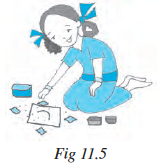
8. Leela is Radha’s younger sister. Leela is 4 years younger than Radha. Can you write Leela’s age in terms of Radha’s age? Take Radha’s age to be x years.
9. Mother has made laddus. She gives some laddus to guests and family members; still 5 laddus remain. If the number of laddus mother gave away is l, how many laddus did she make?
10. Oranges are to be transferred from larger boxes into smaller boxes. When a large box is emptied, the oranges from it fill two smaller boxes and still 10 oranges remain outside. If the number of oranges in a small box are taken to be x, what is the number of oranges in the larger box?
11. (a) Look at the following matchstick pattern of squares (Fig 11.6). The squares are not separate. Two neighbouring squares have a common matchstick. Observe the patterns and find the rule that gives the number of matchsticks in terms of the number of squares. (Hint : If you remove the vertical stick at the end, you will get a pattern of Cs.)

(b) Fig 11.7 gives a matchstick pattern of triangles. As in Exercise 11 (a) above, find the general rule that gives the number of matchsticks in terms of the number of triangles.

11.6 Use of Variables in Common Rules
Let us now see how certain common rules in mathematics that we have already learnt are expressed using variables.
Rules from geometry
We have already learnt about the perimeter of a square and of a rectangle in the chapter on Mensuration. Here, we go back to them to write them in the form of a rule.
1. Perimeter of a square We know that perimeter of any polygon (a closed figure made up of 3 or more line segments) is the sum of the lengths of its sides.A square has 4 sides and they are equal in length (Fig 11.8). Therefore,
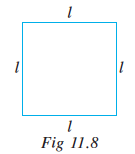
The perimeter of a square = Sum of the lengths of the
sides of the square
= 4 times the length of a side of the square
= 4 × l = 4l.
Thus, we get the rule for the perimeter of a square. The use of the variable l allows us to write the general rule in a way that is concise and easy to remember.
We may take the perimeter also to be represented by a variable, say p. Then the rule for the perimeter of a square is expressed as a relation between the perimeter and the length of the square, p = 4l
2. Perimeter of a rectangle We know that a rectangle has four sides. For example, the rectangle ABCD has four sides AB, BC, CD and DA. The opposite sides of any rectangle are always equal in length. Thus, in the rectangle ABCD, let us denote by l, the length of the sides AB or CD and, by b, the length of the sides AD or BC. Therefore,
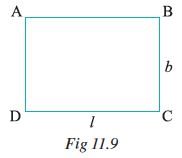
Perimeter of a rectangle = length of AB + length of BC + length of CD
+ length of AD
= 2 × length of CD + 2 × length of BC = 2l + 2b
The rule, therefore, is that the perimeter of a rectangle = 2l + 2b
where, l and b are respectively the length and breadth of the rectangle.
Discuss what happens if l = b.
If we denote the perimeter of the rectangle by the variable p, the rule for perimeter of a rectangle becomes p = 2l + 2b
Note : Here, both l and b are variables. They take on values independent of each other. i.e. the value one variable takes does not depend on what value the other variable has taken.
In your studies of geometry you will come across several rules and formulas dealing with perimeters and areas of plane figures, and surface areas and volumes of three-dimensional figures. Also, you may obtain formulas for the sum of internal angles of a polygon, the number of diagonals of a polygon and so on. The concept of variables which you have learnt will prove very useful in writing all such general rules and formulas.
Rules from arithmetic
3. Commutativity of addition of two numbers
We know that
4 + 3 = 7 and 3 + 4 = 7
i.e. 4 + 3 = 3 + 4


As we have seen in the chapter on whole numbers, this is true for any two numbers. This property of numbers is known as the commutativity of addition of numbers. Commuting means interchanging. Commuting the order of numbers in addition does not change the sum. The use of variables allows us to express the generality of this property in a concise way. Let a and b be two variables which can take any number value.
Then, a + b = b + a
Once we write the rule this way, all special cases are included in it.
If a = 4 and b = 3, we get 4 + 3 = 3 + 4. If a = 37 and b = 73,
we get 37 + 73 = 73 + 37 and so on.
4. Commutativity of multiplication of two numbers
We have seen in the chapter on whole numbers that for multiplication of two numbers, the order of the two numbers being multiplied does not matter. For example,
4 × 3 = 12, 3 × 4 = 12
Hence, 4 × 3 = 3 × 4
This property of numbers is known as commutativity of multiplication of numbers. Commuting (interchanging) the order of numbers in multiplication does not change the product. Using variables a and b as in the case of addition, we can express the commutativity of multiplication of two numbers as a × b = b × a
Note that a and b can take any number value. They are variables. All the special cases like
4 × 3 = 3 × 4 or 37 × 73 = 73 × 37 follow from the general rule.
5. Distributivity of numbers
Suppose we are asked to calculate 7 × 38. We obviously do not know the table of 38. So, we do the following:
7 × 38 = 7 × (30 + 8) = 7 × 30 + 7 × 8 = 210 + 56 = 266
This is always true for any three numbers like 7, 30 and 8. This property is known as distributivity of multiplication over addition of numbers.
By using variables, we can write this property of numbers also in a general and concise way. Let a, b and c be three variables, each of which can take any number. Then, a × (b + c) = a × b + a × c
Properties of numbers are fascinating. You will learn many of them in your study of numbers this year and in your later study of mathematics. Use of variables allows us to express these properties in a very general and concise way. One more property of numbers is given in question 5 of Exercise 11.2. Try to find more such properties of numbers and learn to express them using variables.
Exercise 11.2
1. The side of an equilateral triangle is shown by l. Express the perimeter of the equilateral triangle using l.
2. The side of a regular hexagon (Fig 11.10) is denoted by l. Express the perimeter of the hexagon using l.
(Hint : A regular hexagon has all its six sides equal in length.)
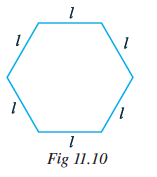
3. A cube is a three-dimensional figure as shown in Fig 11.11. It has six faces and all of them are identical squares. The length of an edge of the cube is given by l. Find the formula for the total length of the edges of a cube.
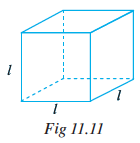
4. The diameter of a circle is a line which joins two points on the circle and also passes through the centre of the circle. (In the adjoining figure (Fig 11.12) AB is a diameter of the circle; C is its centre.) Express the diameter of the circle (d) in terms of its radius (r).
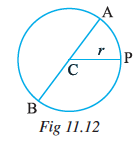
5. To find sum of three numbers 14, 27 and 13, we can have two ways:
(a) We may first add 14 and 27 to get 41 and then add 13 to it to get the total sum 54 or
(b) We may add 27 and 13 to get 40 and then add 14 to get the sum 54.
Thus, (14 + 27) + 13 = 14 + (27 + 13)
This can be done for any three numbers. This property is known as the associativity of addition of numbers. Express this property which we have already studied in the chapter on Whole Numbers, in a general way, by using variables a, b and c.
11.7 Expressions with Variables
Recall that in arithmetic we have come across expressions like (2 × 10) + 3,
3 × 100 + (2 × 10) + 4 etc. These expressions are formed from numbers like 2, 3, 4, 10, 100 and so on. To form expressions we use all the four number operations of addition, subtraction, multiplication and division. For example, to form (2 × 10) + 3, we have multiplied 2 by 10 and then added 3 to the product. Examples of some of the other arithmetic expressions are :
3 + (4 × 5), (– 3 × 40) + 5,
8 – (7 × 2), 14 – (5 – 2),
(6 × 2) – 5, (5 × 7) – (3 × 4),
7 + (8 × 2) (5 × 7) – (3 × 4 – 7) etc.
Expressions can be formed from variables too. In fact, we already have seen expressions with variables, for example: 2n, 5m, x + 10, x – 3 etc. These expressions with variables are obtained by operations of addition, subtraction, multiplication and division on variables. For example, the expression 2n is formed by multiplying the variable n by 2; the expression (x + 10) is formed by adding 10 to the variable x and so on.
We know that variables can take different values; they have no fixed value. But they are numbers. That is why as in the case of numbers, operations of addition, subtraction, multiplication and division can be done on them.
One important point must be noted regarding the expressions containing variables. A number expression like (4 × 3) + 5 can be immediately evaluated as (4 × 3) + 5 = 12 + 5 = 17
But an expression like (4x + 5), which contains the variable x, cannot be evaluated. Only if x is given some value, an expression like (4x + 5) can be evaluated. For example,
when x = 3, 4x + 5 = (4 × 3) + 5 = 17 as found above.
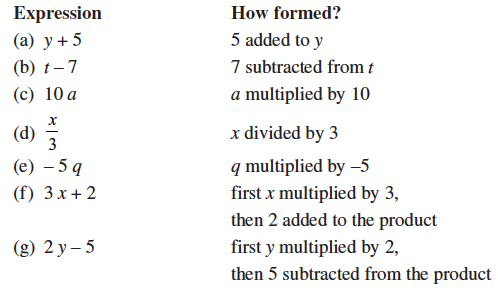
Write 10 other such simple expressions and tell how they have been formed.
We should also be able to write an expression through given instruction about how to form it. Look at the following example :
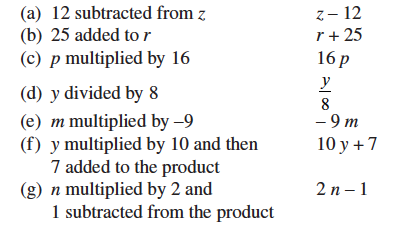
Sarita and Ameena decide to play a game of expressions. They take the variable x and the number 3 and see how many expressions they can make. The condition is that they should use not more than one out of the four number operations and every expression must have x in it. Can you help them?

Is (3x + 5) allowed ?
Is (3x + 3) allowed ?
Sarita thinks of (x + 3).
Then, Ameena comes up with (x – 3).
Next she suggests 3x. Sarita then immediately makes  .
.
Are these the only four expressions that they can get under the given
condition?
Next they try combinations of y, 3 and 5. The condition is that they should use not more than one operation of addition or subtraction and one operation of multiplication or division. Every expression must have y in it. Check, if their answers are right.
In the following exercise we shall look at how few simple expressions have been formed.
y + 5, y + 3, y – 5, y – 3, 3y, 5y,  ,
,  , 3y + 5,
, 3y + 5,
3y – 5, 5y + 3, 5y – 3
Can you make some more expressions?
Is  allowed ?
allowed ?
Is (y + 8) allowed ?
Is 15y allowed ?
Exercise 11.3
1. Make up as many expressions with numbers (no variables) as you can from three numbers 5, 7 and 8. Every number should be used not more than once. Use only addition, subtraction and multiplication.
(Hint : Three possible expressions are 5 + (8 – 7), 5 – (8 – 7), (5 × 8) + 7; make the other expressions.)
2. Which out of the following are expressions with numbers only?

(a) y + 3 (b) (7 × 20) – 8z
(c) 5 (21 – 7) + 7 × 2 (d) 5
(e) 3x (f) 5 – 5n
(g) (7 × 20) – (5 × 10) – 45 + p
3. Identify the operations (addition, subtraction, division, multiplication) in forming the following expressions and tell how the expressions have been formed.
(a) z +1, z – 1, y + 17, y – 17 (b) 17y,  , 5 z
, 5 z
(c) 2y + 17, 2 y – 17 (d) 7 m, – 7 m + 3, – 7 m – 3
4. Give expressions for the following cases.
(a) 7 added to p (b) 7 subtracted from p
(c) p multiplied by 7 (d) p divided by 7
(e) 7 subtracted from – m (f) – p multiplied by 5
(g) – p divided by 5 (h) p multiplied by – 5
5. Give expressions in the following cases.
(a) 11 added to 2m (b) 11 subtracted from 2m
(c) 5 times y to which 3 is added (d) 5 times y from which 3 is subtracted
(e) y is multiplied by – 8
(f) y is multiplied by – 8 and then 5 is added to the result
(g) y is multiplied by 5 and the result is subtracted from 16
(h) y is multiplied by – 5 and the result is added to 16.
6. (a) Form expressions using t and 4. Use not more than one number operation. Every expression must have t in it.
(b) Form expressions using y, 2 and 7. Every expression must have y in it. Use only two number operations. These should be different.
11.8 Using Expressions Practically
We have already come across practical situations in which expressions are useful. Let us remember some of them.
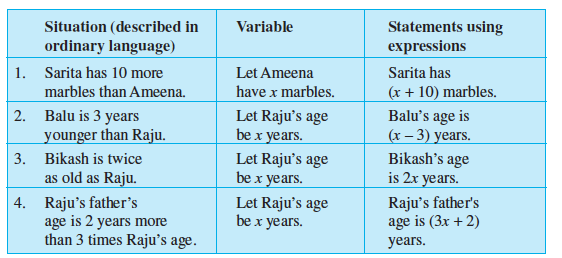
Let us look at some other such situations.
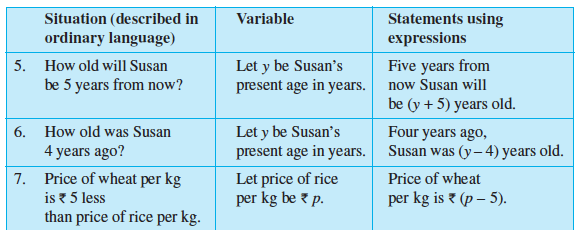

Try to find more such situations. You will realise that there are many statements in ordinary language, which you will be able to change to statements using expressions with variables. In the next section, we shall see how we use these statements using expressions for our purpose.
Exercise 11.4
1. Answer the following:
(a) Take Sarita’s present age to be y years
(i) What will be her age 5 years from now?
(ii) What was her age 3 years back?
(iii) Sarita’s grandfather is 6 times her age. What is the age of her grandfather?
(iv) Grandmother is 2 years younger than grandfather. What is grandmother’s age?
(v) Sarita’s father’s age is 5 years more than 3 times Sarita’s age. What is her father’s age?
(b) The length of a rectangular hall is 4 meters less than 3 times the breadth of the hall. What is the length, if the breadth is b meters?

(c) A rectangular box has height h cm. Its length is 5 times the height and breadth is 10 cm less than the length. Express the length and the breadth of the box in terms of the height.
(d) Meena, Beena and Leena are climbing the steps to the hill top. Meena is at step s, Beena is 8 steps ahead and Leena 7 steps behind. Where are Beena and Meena? The total number of steps to the hill top is 10 less than 4 times what Meena has reached. Express the total number of steps using s.
(e) A bus travels at v km per hour. It is going from Daspur to Beespur. After the bus has travelled 5 hours, Beespur is still 20 km away. What is the distance from Daspur to Beespur? Express it using v.
2. Change the following statements using expressions into statements in ordinary
language.
(For example, Given Salim scores r runs in a cricket match, Nalin scores (r + 15) runs. In ordinary language – Nalin scores 15 runs more than Salim.)
(a) A notebook costs ₹ p. A book costs ₹ 3 p.
(b) Tony puts q marbles on the table. He has 8 q marbles in his box.
(c) Our class has n students. The school has 20 n students.
(d) Jaggu is z years old. His uncle is 4 z years old and his aunt is (4z – 3) years old.
(e) In an arrangement of dots there are r rows. Each row contains 5 dots.
3. (a) Given Munnu’s age to be x years, can you guess what (x – 2) may show?
(Hint : Think of Munnu’s younger brother.)
Can you guess what (x + 4) may show? What (3 x + 7) may show?
(b) Given Sara’s age today to be y years. Think of her age in the future or in the past. What will the following expression indicate? y + 7, y – 3, y + , y –
, y –  .
.
(c) Given n students in the class like football, what may 2n show? What may  show? (Hint : Think of games other than football).
show? (Hint : Think of games other than football).
11.9 What is an Equation?
Let us recall the matchstick pattern of the letter L given in Fig 11.1. For our convenience, we have the Fig 11.1 redrawn here.

The number of matchsticks required for different number of Ls formed was given in Table 1. We repeat the table here.

We know that the number of matchsticks required is given by the rule,
2n, if n is taken to be the number of Ls formed.
Appu always thinks differently. He asks, “We know how to find the number of matchsticks required for a given number of Ls. What about the other way round? How does one find the number of Ls formed, given the number of matchsticks”?
We ask ourselves a definite question.
How many Ls are formed if the number of matchsticks given is 10?
This means we have to find the number of Ls ( i.e. n), given the number of matchsticks 10. So, 2n = 10 (1)
Here, we have a condition to be satisfied by the variable n. This condition is an example of an equation.
Our question can be answered by looking at Table 1. Look at various values of n. If n = 1, the number of matchsticks is 2. Clearly, the condition is not satisfied, because 2 is not 10. We go on checking.
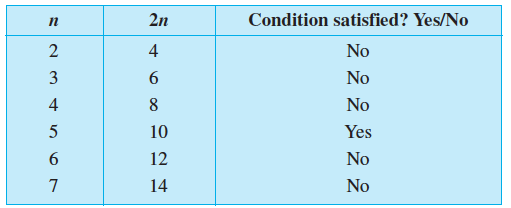
We find that only if n = 5, the condition, i.e. the equation 2n = 10 is satisfied. For any value of n other than 5, the equation is not satisfied.
Let us look at another equation.
Balu is 3 years younger than Raju. Taking Raju’s age to be x years, Balu’s age is (x – 3) years. Suppose, Balu is 11 years old. Then, let us see how our method gives Raju’s age.
We have Balu’s age, x – 3 = 11 (2)
This is an equation in the variable x. We shall prepare a table of values of
(x – 3) for various values of x.

Complete the entries which are left blank. From the table, we find that only for x = 14, the condition x – 3 = 11 is satisfied. For other values,
for example for x = 16 or for x = 12, the condition is not satisfied. Raju’s age, therefore, is 14 years.
To summarise, any equation like the above, is a condition on a variable. It is satisfied only for a definite value of the variable. For example, the equation 2n = 10 is satisfied only by the value 5 of the variable n. Similarly, the equation x – 3 = 11 is satisfied only by the value 14 of the variable x.
Note that an equation has an equal sign (=) between its two sides. The equation says that the value of the left hand side (LHS) is equal to the value of the right hand side (RHS). If the LHS is not equal to the RHS, we do not get an equation.
For example : The statement 2n is greater than 10, i.e. 2n > 10 is not an equation. Similarly, the statement 2n is smaller than 10 i.e. 2n < 10 is not an equation. Also, the statements
(x – 3) > 11 or (x – 3) < 11 are not equations.
Now, let us consider 8 – 3 = 5
There is an equal sign between the LHS and RHS. Neither of the two sides contain a variable. Both contain numbers. We may call this a numerical equation. Usually, the word equation is used only for equations with one or more variables.
Let us do an exercise. State which of the following are equations with a variable. In the case of equations with a variable, identify the variable.
(a) x + 20 = 70 (Yes, x)
(b) 8 × 3 = 24 (No, this a numerical equation)
(c) 2p > 30 (No)
(d) n – 4 = 100 (Yes, n)
(e) 20b = 80 (Yes, b)
(f)  < 50 (No)
< 50 (No)
Following are some examples of an equation. (The variable in the equation is also identified).
Fill in the blanks as required :
x + 10 = 30 (variable x) (3)
p – 3 = 7 (variable p) (4)
3n = 21 (variable ____ ) (5)
 = 4 (variable ____ ) (6)
= 4 (variable ____ ) (6)
2l + 3 = 7 (variable ____ ) (7)
2m – 3 = 5 (variable ____ ) (8)
11.10 Solution of an Equation
We saw in the earlier section that the equation
2n = 10 (1)
was satisfied by n = 5. No other value of n satisfies the equation. The value of the variable in an equation which satisfies the equation is called a solution to the equation. Thus, n = 5 is a solution to the equation 2 n = 10.
Note, n = 6 is not a solution to the equation 2n = 10; because for n = 6,
2n = 2 × 6 = 12 and not 10.
Also, n = 4 is not a solution. Tell, why not?
Let us take the equation x – 3 = 11 (2)
This equation is satisfied by x = 14, because for x = 14,
LHS of the equation = 14 – 3 = 11 = RHS
It is not satisfied by x = 16, because for x = 16,
LHS of the equation = 16 – 3 = 13, which is not equal to RHS.
Thus, x = 14 is a solution to the equation x – 3 = 11 and x = 16 is not a solution to the equation. Also, x = 12 is not a solution to the equation. Explain, why not?
Now complete the entries in the following table and explain why your answer is Yes/No.
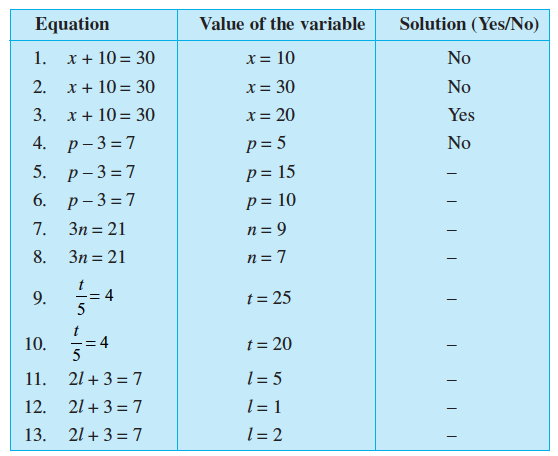
In finding the solution to the equation 2n = 10, we prepared a table for various values of n and from the table, we picked up the value of n which was the solution to the equation (i.e. which satisfies the equation). What we used is a trial and error method. It is not a direct and practical way of finding a solution. We need a direct way of solving an equation, i.e. finding the solution of the equation. We shall learn a more systematic method of solving equations only next year.
Beginning of Algebra
It is said that algebra as a branch of Mathematics began about 1550 BC, i.e. more than 3500 years ago, when people in Egypt started using symbols to denote unknown numbers.
Around 300 BC, use of letters to denote unknowns and forming expressions from them was quite common in India. Many great Indian mathematicians, Aryabhatt(born 476AD), Brahmagupta (born 598AD), Mahavira (who lived around 850AD) and Bhaskara II (born 1114AD) and others, contributed a lot to the study of algebra. They gave names such as Beeja, Varna etc. to unknowns and used first letters of colour names [e.g., ka from kala (black), nee from neela (blue)] to denote them. The Indian name for algebra, Beejaganit, dates back to these ancient Indian mathematicians.
The word ‘algebra’ is derived from the title of the book, ‘Aljebar w’al almugabalah’, written about 825AD by an Arab mathematician, Mohammed Ibn Al Khowarizmi of Baghdad.
Exercise 11.5
1. State which of the following are equations (with a variable). Give reason for your answer. Identify the variable from the equations with a variable.
(a) 17 = x + 7 (b) (t – 7) > 5 (c)  = 2
= 2
(d) (7 × 3) – 19 = 8 (e) 5 × 4 – 8 = 2 x (f) x – 2 = 0
(g) 2m < 30 (h) 2n + 1 = 11 (i) 7 = (11 × 5) – (12 × 4)
(j) 7 = (11 × 2) + p (k) 20 = 5y (l)  < 5
< 5
(m) z + 12 > 24 (n) 20 – (10 – 5) = 3 × 5
(o) 7 – x = 5
2. Complete the entries in the third column of the table.
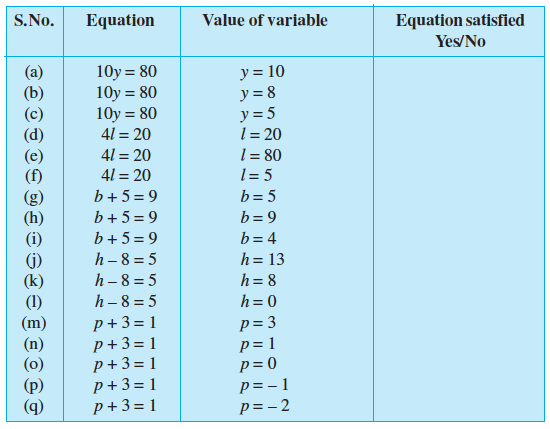
3. Pick out the solution from the values given in the bracket next to each equation. Show that the other values do not satisfy the equation.
(a) 5m = 60 (10, 5, 12, 15)
(b) n + 12 = 20 (12, 8, 20, 0)
(c) p – 5 = 5 (0, 10, 5 – 5)
(d)  = 7 (7, 2, 10, 14)
= 7 (7, 2, 10, 14)
(e) r – 4 = 0 (4, – 4, 8, 0)
(f) x + 4 = 2 (– 2, 0, 2, 4)
4. (a) Complete the table and by inspection of the table find the solution to the equation m + 10 = 16.

(b) Complete the table and by inspection of the table, find the solution to the equation 5t = 35.

(c) Complete the table and find the solution of the equation z/3 =4 using the
table.

(d) Complete the table and find the solution to the equation m – 7 = 3.

5. Solve the following riddles, you may yourself construct such riddles.
Who am I?
(i) Go round a square
Counting every corner
Thrice and no more!
Add the count to me
To get exactly thirty four!
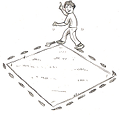
(ii) For each day of the week
Make an upcount from me
If you make no mistake
You will get twenty three!
(iii) I am a special number
Take away from me a six!
A whole cricket team
You will still be able to fix!

(iv) Tell me who I am
I shall give a pretty clue!
You will get me back
If you take me out of twenty two!
What have we discussed?
1. We looked at patterns of making letters and other shapes using matchsticks. We learnt how to write the general relation between the number of matchsticks required for repeating a given shape. The number of times a given shape is repeated varies; it takes on values 1,2,3,... . It is a variable, denoted by some letter like n.
2. A variable takes on different values, its value is not fixed. The length of a square can have any value. It is a variable. But the number of angles of a triangle has a fixed value 3. It is not a variable.
3. We may use any letter n, l, m, p, x, y, z, etc. to show a variable.
4. A variable allows us to express relations in any practical situation.
5. Variables are numbers, although their value is not fixed. We can do the operations of addition, subtraction, multiplication and division on them just as in the case of fixed numbers. Using different operations we can form expressions with variables like x – 3, x + 3, 2n, 5m,  , 2y + 3, 3l – 5, etc.
, 2y + 3, 3l – 5, etc.
6. Variables allow us to express many common rules in both geometry and arithmetic in a general way. For example, the rule that the sum of two numbers remains the same if the order in which the numbers are taken is reversed can be expressed as
a + b = b + a. Here, the variables a and b stand for any number, 1, 32, 1000 – 7, – 20, etc.
7. An equation is a condition on a variable. It is expressed by saying that an expression with a variable is equal to a fixed number, e.g. x – 3 = 10.
8. An equation has two sides, LHS and RHS, between them is the equal (=) sign.
9. The LHS of an equation is equal to its RHS only for a definite value of the variable in the equation. We say that this definite value of the variable satisfies the equation. This value itself is called the solution of the equation.
10. For getting the solution of an equation, one method is the trial and error method. In this method, we give some value to the variable and check whether it satisfies the equation. We go on giving this way different values to the variable` until we find the right value which satisfies the equation.

